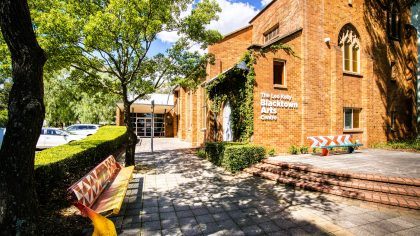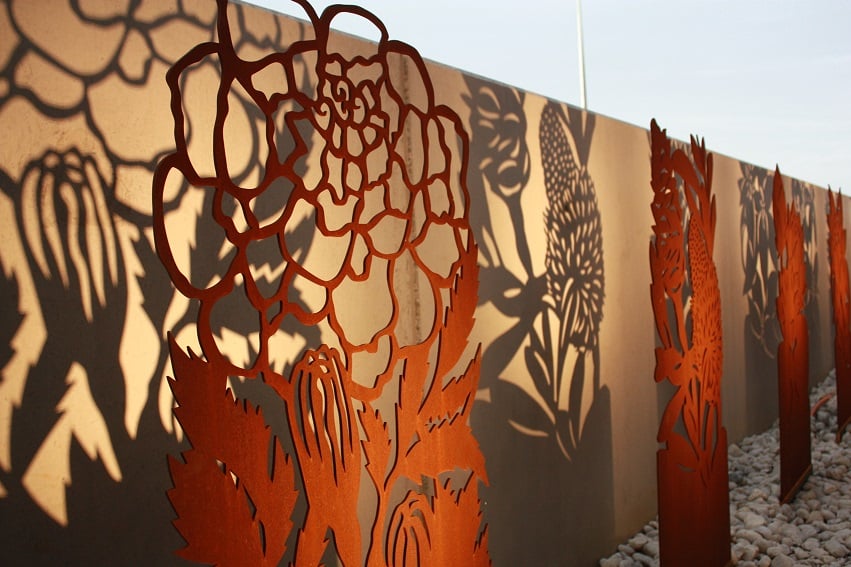
The Leo Kelly Blacktown Arts Centre
An innovative multi-arts hub in the heart of Blacktown City.
Bayadyinyang budyari Dharug yiyura Dharug Ngurra.
Bayady’u budyari Dharug Warunggadgu baranyiin barribugu.
Bayady’u budyari wagulgu yiyuragu Ngurra bimalgu Blacktown City. Flannel flowers dyurali bulbuwul.
Yanmannyang mudayi Dharug Ngurrawa. Walama ngyini budbud dali Dharug Ngurra Dharug yiyura baranyiin barribugu.
We acknowledge the Traditional Custodians of this Land, the Dharug people, and their continued connection to Country.
We pay our respects to Elders from yesterday to tomorrow.
We extend that respect to all Aboriginal and Torres Strait Islander Peoples of Blacktown City where the flannel flowers still grow proud and strong.
We will walk softly on this land and open our hearts to Country as the Dharug people have for tens of thousands of years.
Credit to: Dharug woman Rhiannon Wright, daughter of Leanne ‘Mulgo’ Watson Redpath and granddaughter of Aunty Edna Watson

Tell us about The Migration Project – your large public commission in Wollongong – and, in particular, the process of working with the community and fabricators to realise it?
I saw this commission advertised by Wollongong City Council and, because it was about migration, I decided to apply for it. It was a major landmark site which demanded that it be a silhouette shape and quite tall. Responding to the theme and site, I designed a skeletal boat frame with ladders. I knew I wanted to use steel because being in Wollongong it made sense, and I knew I wanted it to be made locally, as opposed to suggestions that I send it offshore for fabrication. During the process of figuring out how I was going to make it, the cost kept escalating and I realised that I couldn’t afford to use the stainless steel that I’d proposed, so I put out an email to the migrant community who had been instrumental in instigating the project. I had a generous response from a man offering help at every stage from steel fabrication to in-kind support for installation. It was such an exciting development because he also wanted to involve local people and I realised the project was going to have that real community involvement. In the end, his support meant that I was able to work closely with this fabulous steel manufacturing company. Then, Council came back to me and said they wanted more work. From what I’d already submitted they chose one that involved three laser-cut steel panels on poles. Fortunately, there had previously been an historian commissioned to do local research, so I was able to draw on that work, as well as on local photographic archives for my imagery, which helped connect it to the community. It took more than a year to realise it.
Last year, Blacktown City Council commissioned you to undertake another public artwork at the Glenwood Community Hub.
Can you describe the process of community engagement in realising that project?
Again, this was a commission for which I was invited to apply. I believe they picked my submission because I mentioned there would be an extensive community engagement process in the lead-up to it. Glenwood is a relatively new Western Sydney suburb hemmed in by three major motorways. It is also home to a Sikh Temple, so a lot of Sikh people live there, but beyond that it’s a very diverse community, so I felt the project needed to be about diversity. I got the idea to make the project about plants through observing my Sri Lankan neighbour. She was a terrific gardener and she grew all the things that she had in Sri Lanka – okra, chillies, lime – and I realised I had planted kangaroo paw because I’m from Western Australia. I thought these plants have meaning for her in the same way as this plant has meaning for me. I was curious to know what plants the people of Glenwood planted to remind them of home. I decided to conduct a survey through a series of drawing workshops with kids from Glenwood High School, with people who use the Glenwood Community Hall, and I went to the Sikh Temple and had talks with people about the plantings there. Marigolds featured prominently in that research. Then, in more depth I had engagement with a group of Indian women. I spent more time with them and realised that they did henna painting, and so they loved doing really intricate drawings of plants. I was surprised by some of the plants which were popular with them – basil, for instance, frangipanis, mustard, and cherry blossom. There was a whole range of plants that came up. I chose eight of the plants which featured most and then created the designs which were to be a row of laser cut steel panels to be installed outside a glass wall of the new addition to the Glenwood Community Hub. I’d collected comments which formed the basis for texts etched onto the glass in front of the panels. The effect was a layering of meaning. When people came to the centre they knew what the work was about – they had had some input to it and therefore had some context for it. The design came from me, but the content came from them.
Your work has a very poetic quality. What artists have influenced your own practice?
I look at work all the time, but there’s one I’ve been thinking about – Krzysztof Wodiczco. Even though he’s a video artist and that’s not my medium, I really like the way he works with people and the content of his work. I’ve read about the way he engages with people and he really manages to get under the surface of issues. His projections are on public sites, often monuments, and that means they change the perceptions of that place. Even after the projection is gone, it lingers in the memory. His work is often about people who are marginalised, people who don’t have a voice. That approach appeals to me – how artists can be successful in bringing those issues to the fore. Closer to home, I am interested in Hossein and Angela Valamanesh because their work is so poetic and beautifully made and, again, has that cross-cultural aspect. It speaks about coming from somewhere else and how one culture is laid over another, because Hossein comes from Iran. Other artists whose work has interested me recently have been Alfredo and Isabel Aquilizan. They come from the Philippines, and work closely with the Filipino community gathering things – objects and stories – and also allowing the process of participation in building installations.
Like many artists, you also work as a teacher. How has teaching influenced your practice?
It is a way for me to hone my skills in communication and understanding other people, so I feel more confident stepping into a situation where I’m working with groups. When you work in a socially engaged art project, the criticism often is that you fly in and fly out again. The challenge for the artist is to really meet people, get to know them and that can take time. I think that teaching has given me the skill – a way to give something back, to get people involved. It’s also a way to survive as an artist. Apart from that I do really enjoy it – the energy of engagement. I feel it’s a great privilege to be in that role.
Your personal circumstances have changed dramatically this year with your cancer diagnosis. Could you talk a little about the impact this has had on the way you are thinking about your practice?
Yes, we should perhaps explain that this interview is happening in Day Therapy (at the Chris O’Brien Lifehouse Cancer Centre) while I’m receiving chemotherapy. I’ve had a lot of time to reflect on how things were before I got the diagnosis and then after I got the diagnosis. Before diagnosis, I was about to start a project in Blacktown called Social Scaffold working with people who were learning English and I was very disappointed not to be able to do that – it really stopped me in my tracks. I’ve thought a lot about how I would love to get back to doing that project. I’d also just embarked on a PhD at Sydney College of the Arts and that had to go on hold too. Getting well, taking care of myself, has been like a full-time job. In the beginning I thought that I’d put everything on hold and come back to it, but I think something deep within me has shifted – it has to because it’s a life-changing experience. I’m sure there’ll be some way that I can use the process of making art to work through this, maybe not right now, but it will come out later. My friends have been a great help to me, and I really value the support offered by the staff at Blacktown Arts Centre and being included in the Diaspora-Making Machines exhibition. Also I’ve been thinking about the artist residency program here in this terrific building (Chris O’Brien Lifehouse). When I was first diagnosed and coming along to appointments here, I met Renuka Fernando, who was artist in residence. I was here with my son and we got the chance to participate in her workshop. It was a role reversal for me; usually I’m the one facilitating that kind of activity. I realised how important and enriching it was, and now every time I see that space where she was working, I really miss her presence. It wasn’t until then that I thought, ‘Ah we artists really do make an impact on the people around us’, which was very affirming. I thought maybe when I’m finished all this I might like to do something here. But I don’t know where this will lead, what’s coming up next, but this situation is bound to impact on my practice.
Exhibition | Diaspora-Making Machines
Thursday, 29 September – Saturday, 5 November 2016
Diaspora-Making Machines is an exhibition that explores the systemic devices (the machines) that generate movement and the dispersal of communities (the diaspora). Blacktown is a site of continuous waves of migration. Since Governor Macquarie issued the first land grant to Nurragingy and Colebee in 1816, communities have been moving to Blacktown – sometimes by choice, sometimes by force. Eight artists engage with Blacktown’s historic place as a centre of migration, our attitudes to newcomers, and notions of belonging and assimilation.Elin Howe is an art historian and writer with an interest in contemporary art. She has taught art history/theory at university and TAFE.